
Zustellung: Do, 17.07. - Di, 22.07.
Versand in 2 Wochen
VersandkostenfreiBestellen & in Filiale abholen:
In The Crusades and the Christian World of the East, Christopher MacEvitt marshals an impressive array of literary, legal, artistic, and archeological evidence to demonstrate how crusader ideology and religious difference gave rise to a mode of coexistence he calls "rough tolerance."
Inhaltsverzeichnis
Note on Transliteration and Names
Map
Introduction
The Twelfth-Century Middle East
Historiography of the Crusades
Rough Tolerance: A New Model of Religious Interaction
1 Satan Unleashed: The Christian Levant in the Eleventh Century
A Brief History of the Christian East
Contact and Knowledge Between Eastern and Western Christians
2 Close Encounters of the Ambiguous Kind: When Crusaders and Locals Meet
Responses to the First Crusade
The Franks in Edessa
Armenian Resistance
3 Images of Authority in Edessa, 1100-1150
Frankish Authority
Armenian Authority: A Response to the Franks
Edessa Under Joscelin I
Edessa and the Frankish East
4 Rough Tolerance and Ecclesiastical Ignorance
Local Christians from a Latin Perspective
Local Priests and Patriarchs in the Frankish Levant
Architecture and Liturgy
Pilgrimage
5 The Legal and Social Status of Local Inhabitants in the Frankish Levant
Historiography
The Peasantry
Local Rural Landowners and Administrators
6 The Price of Unity: Ecumenical Negotiations and the End of Rough Tolerance
Manuel I Komnenos and the Mediterranean World
Ecumenical Dialogue with the Armenian Church
Jacobite Patriarch Michael and the Quest for Legitimacy
Cultural Consequences of Ecumenical Negotiation
Conclusion
Notes
Bibliography
Index
Acknowledgments
Map
Introduction
The Twelfth-Century Middle East
Historiography of the Crusades
Rough Tolerance: A New Model of Religious Interaction
1 Satan Unleashed: The Christian Levant in the Eleventh Century
A Brief History of the Christian East
Contact and Knowledge Between Eastern and Western Christians
2 Close Encounters of the Ambiguous Kind: When Crusaders and Locals Meet
Responses to the First Crusade
The Franks in Edessa
Armenian Resistance
3 Images of Authority in Edessa, 1100-1150
Frankish Authority
Armenian Authority: A Response to the Franks
Edessa Under Joscelin I
Edessa and the Frankish East
4 Rough Tolerance and Ecclesiastical Ignorance
Local Christians from a Latin Perspective
Local Priests and Patriarchs in the Frankish Levant
Architecture and Liturgy
Pilgrimage
5 The Legal and Social Status of Local Inhabitants in the Frankish Levant
Historiography
The Peasantry
Local Rural Landowners and Administrators
6 The Price of Unity: Ecumenical Negotiations and the End of Rough Tolerance
Manuel I Komnenos and the Mediterranean World
Ecumenical Dialogue with the Armenian Church
Jacobite Patriarch Michael and the Quest for Legitimacy
Cultural Consequences of Ecumenical Negotiation
Conclusion
Notes
Bibliography
Index
Acknowledgments
Produktdetails
Erscheinungsdatum
10. September 2009
Sprache
englisch
Seitenanzahl
280
Autor/Autorin
Christopher Macevitt
Verlag/Hersteller
Produktart
kartoniert
Gewicht
421 g
Größe (L/B/H)
227/151/27 mm
ISBN
9780812220834
Entdecken Sie mehr
Pressestimmen
"A first-rate piece of scholarship that will have a major impact on the field of crusade studies and medieval history in general... A must for all historians of the Latin East and those interested in relations between the churches."-Jonathan Riley-Smith, author of The First Crusade and the Idea of Crusading "A superb contribution to understanding the complex interaction of local and occupying Christian populations during the crusading era... Highly recommended."-Choice "An important book, which shows that the Western settlers did not remain a foreign presence but became fully integrated in the society of the Levant."-TLS
Bewertungen
0 Bewertungen
Es wurden noch keine Bewertungen abgegeben. Schreiben Sie die erste Bewertung zu "The Crusades and the Christian World of the East" und helfen Sie damit anderen bei der Kaufentscheidung.









